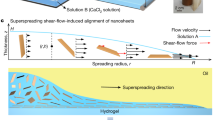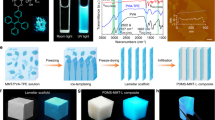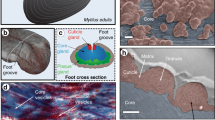Abstract
Nanocomposite materials are widespread in biological systems. Perhaps the most studied is the nacre of abalone shell, an orientated coating composed of alternating layers of aragonite (CaCO3) and a biopolymer. Its laminated structure simultaneously provides strength, hardness and toughness: containing about 1 vol. % polymer, nacre is twice as hard and 1,000 times as tough as its constituent phases1. Such remarkable properties have inspired chemists and materials scientists to develop synthetic, ‘biomimetic’ nanocomposite assemblies2,3,4,5. Nonetheless, the efficient processing of layered organic–inorganic composites remains an elusive goal. Here we report a rapid, efficient self-assembly process for preparing nanolaminated coatings that mimic the structure of nacre. Beginning with a solution of silica, surfactant and organic monomers, we rely on evaporation during dip-coating to induce the formation of micelles and partitioning of the organic constituents into the micellar interiors6. Subsequent self-assembly of the silica–surfactant–monomer micellar species into lyotropic mesophases7 simultaneously organizes the organic and inorganic precursors into the desired nanolaminated form. Polymerization fixes this structure, completing the nanocomposite assembly process. This approach may be generalized both to other composite architectures and to other materials combinations.
This is a preview of subscription content, access via your institution
Access options
Subscribe to this journal
Receive 51 print issues and online access
$199.00 per year
only $3.90 per issue
Buy this article
- Purchase on Springer Link
- Instant access to full article PDF
Prices may be subject to local taxes which are calculated during checkout





Similar content being viewed by others
References
Jackson, A., Vincent, J. & Turner, R. The mechanical design of nacre. Proc. R. Soc. Lond. B 234, 415–425 (1988).
Aksay, I. et al. Biomimetic pathways for assembling inorganic thin films. Science 273, 892–898 (1996).
Bunker, B. et al. Ceramic thin-film formation on functionalized interfaces through biomimetic processing. Science 264, 48–55 (1994).
Heuer, A. et al. Innovative materials processing strategies: a biomimetric approach. Science 255, 1098–1105 (1992).
Mann, S. Molecular tectonics in biomineralization and biomimetics materials chemistry. Nature 365, 499–505 (1993).
Lu, Y. et al. Continuous formation of supported cubic and hexagonal mesoporous films by sol-gel dip-coating. Nature 389, 364–368 (1997).
Kresge, C., Leonowicz, M., Roth, W., Vartuli, C. & Beck, J. Ordered mesoporous molecular sieves synthesized by a liquid-crystal template mechanism. Nature 359, 710–712 (1992).
Heywood, B. & Mann, S. Template-directed nucleation and growth of inorganic materials. Adv. Mater. 6, 9–19 (1994).
Tarasevich, B., Rieke, P. & Liu, J. Nucleation and growth of oriented ceramic films onto organic interfaces. Chem. Mater. 8, 292–300 (1996).
Yang, H., Kuperman, A., Coombs, N., Mamiche-Afara, S., Ozin, G. Synthesis of oriented films of mesoporous silica on mica. Nature 379, 703–705 (1996).
Keller, S., Kim, H. & Mallouk, T. Layer-by-layer assembly of intercalation compounds and heterostructures on surfaces: toward molecular “beaker” epitaxy. J. Am. Chem. Soc. 116, 8817–8818 (1994).
Ogawa, M. Formation of novel oriented transparent films of layered silica-surfactant nanocomposites. J. Am. Chem. Soc. 116, 7941–7942 (1994).
Okada, H., Sakata, K. & Kunitake, T. Formation of oriented iron oxide particles in cast multibilayer films. Chem. Mater. 2, 91–93 (1990).
Tanev, P. & Pinnavaia, T. Biomimetic templating of porous lamellar silicas by vesicular surfactant assemblies. Science 271 1267–1269 (1996).
Burkett, S., Sims, S. & Mann, S. Synthesis of hybrid inorganic-organic mesoporous silica by co-condensation of siloxane and organosiloxane precursors. Chem. Commun. 11, 1367–1368 (1996).
Brinker, C., Sehgal, R., Raman, N., Schunk, P. & Headley, T. Polymer approach to supported silica membranes. J. Sol-Gel Sci. Technol. 2, 469–476 (1994).
Pretsch, E., Siebl, J., Simon, W. & Clerc, T. in Tables of Spectral Data for Structure Determination of Organic Compounds(eds Pretsch, E., Siebl, J., Simon, W. & Clerc, T.) I141–I142 (Springer, Berlin, (1989)).
Yang, H., Coombs, N., Dag, O., Sokolov, I. & Ozin, G. Free-standing mesoporous silica films; morphogenesis of channel and surface patterns. J. Mater. Chem. 7, 1755–1761 (1997).
Giannelis, E. Polymer layered silicate nanocomposites. Adv. Mater. 8, 29–35 (1996).
Gray, D., Hu, S., Juang, E. & Gin, D. Highly ordered polymer-inorganic nanocomposites via monomer self-assembly: in situ condensation approach. Adv. Mater. 9, 731–736 (1997).
Templin, M. et al. Organically-modified aluminosilicate mesostructures from block-copolymer phases. Science 278, 1795–1798 (1997).
Huber, C., Moller, K. & Bein, T. Reactivity of a trimethylstannyl molybdenum complex in mesoporous MCM-41. J. Chem. Soc. 2619–2620 (1994).
Wu, C. & Bein, T. Conducting polyaniline filaments in a mesoporous channel host. Science 264, 1757–1759 (1994).
Ozin, G. Nanochemistry: synthesis in diminishing dimensions. Adv. Mater. 4, 612–649 (1992).
Nishida, F. et al. In situ fluorescence probing of the chemical changes during sol-gel thin film formation. J. Am. Ceram. Soc. 78, 1640–1648 (1995).
Manne, S., Cleveland, J., Gaub, H., Stucky, G. & Hansma, P. Direct visualization of the surfactant hemimicelles by force microscopy of the electrical double layer. Langmuir 10, 4409–4413 (1994).
Bull, L. et al. in Zeolites and Related Microporous Materials: State of the Art 1994(eds Weitkamp, J., Karge, H., Pfeifer, H. & Holderich, W.) 429–434 (Elsevier, Amsterdam, (1994)).
Israelachvili, J. Intermolecular and Surface Forces(Academic, San Diego, (1992)).
Odian, G. Principles of Polymerization(Wiley, New York, (1981)).
Yang, H., Coombs, N., Sokolov, I. & Ozin, G. Free-standing and oriented mesoporous silica films grown at the air-water interface. Nature 381, 589–592 (1996).
Acknowledgements
We thank S. Singh, R. Tissot, S. Rao, Y. Guo and D. Schmale for assistance with experimental portions of this work, and M. Aragon and K. Burns for technical illustrations. This work was supported in part by the UNM/NSF Center for Micro-Engineered Materials, DOE Basic Energy Sciences, and SNL's Laboratory-Directed Research and Development Program (LDRD); and by the US Department of Energy. Sandia is a multiprogram laboratory operated by Sandia Corporation, a Lockheed Martin Company, for the US Department of Energy.
Author information
Authors and Affiliations
Corresponding author
Rights and permissions
About this article
Cite this article
Sellinger, A., Weiss, P., Nguyen, A. et al. Continuous self-assembly of organic–inorganic nanocomposite coatings that mimic nacre. Nature 394, 256–260 (1998). https://doi.org/10.1038/28354
Received:
Accepted:
Issue Date:
DOI: https://doi.org/10.1038/28354
This article is cited by
-
Reduced graphene oxide/silk fibroin/cellulose nanocrystal-based wearable sensors with high efficiency and durability for physiological monitoring
Cellulose (2023)
-
Photo-responsive degradable hollow mesoporous organosilica nanoplatforms for drug delivery
Journal of Nanobiotechnology (2020)
-
Control of Porosity in Freeze Casting
JOM (2020)
-
Artificial nacre-like layer using layer coating with bioinspired mesolayer insertions
SN Applied Sciences (2020)
-
Quaternized cellulose and graphene oxide crosslinked polyphenylene oxide based anion exchange membrane
Scientific Reports (2019)
Comments
By submitting a comment you agree to abide by our Terms and Community Guidelines. If you find something abusive or that does not comply with our terms or guidelines please flag it as inappropriate.



